

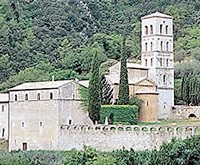
According to Ludovico Jacobilli, Duke Faroald I of Spoleto established a monastery here dedicated to St Peter in 575 AD for SS Lazarus and John, two of the 300 Syrians who had fled to Rome some 60 years previously. Faroald II, who renounced the dukedom of Spoleto in 720, apparently became a monk at San Pietro, where he died and was buried in 728. (For the historical background, see the page on the Lombard Duchy of Spoleto).
Saracens destroyed the abbey in 881: the Emperor Otto III restored it in 996 and the Emperor Henry II financed further work in 1016. The earliest surviving documents that relate to the abbey date to 1152.
In 1234, Pope Gregory IX placed it under the jurisdiction of the Cistercian Abbazia di Chiaravalle in order to effect its reform. The abbey first appears in the archives of Chiaravalle in 1256. Later entries point to a series of disputes and these seem to have impeded the course of reform. In 1303, Pope Boniface VIII condemned the malice and discordant nature of the abbot and monks and transferred the complex to the Lateran Canons.
In 1477, Pope Sixtus IV granted the abbey in commendam to the Ancaiani family, although matters became complicated when Pope Innocent VIII made his illegitimate son, Franceschetto Cybo the hereditary Count of Ferentillo. When the Cybo family became extinct in 1730, the title to Ferentillo was sold to Duke Nicolò Benedetti.
Ferentillo became a Commune after the unification of Italy in 1860, and the new Commune duly took possession of the abbey. Decio Ancaiani bought it in 1890. In 1917, the last descendant of the Ancaiani family, Serafina Gianavei gave the church to the parish priest and sold the rest of the complex to Ermete Costanzi, who immediately began its restoration. This work was complete by 1931, when Benito Mussolini re-opened the complex.
The monastery is now a hotel but the church is usually open to the public.
Possessions of San Pietro in Valle
In 1231, Pope Gregory IX confirmed two churches in Terni, San Giovanni Evangelista de Platea and San Cristoforo, as possessions of the abbey.
The ancient church of San Salvatore, Spoleto belonged to the abbey until 1248, when the papal legate, Raniero Capocci arranged for it to be given to the Dominicans. They later demolished it to make way for the present church of San Domenico.
Exterior of the Church
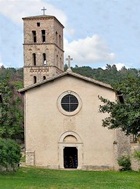
It is worth walking round to the back of the church to see the apse, the two apsidal chapels and the campanile (12th century). Architectural fragments, including some from the 8th century, have been embedded in it. There is a lovely view from here of the Castello di Umbriano.
The first cloister (11th century) is reached by a door on the right of the church (see below). It contains two orders of arches and has a pagan altar at its centre. The second cloister dates to the 15th century.
Interior
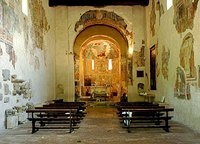
The church is in the form of a long high hall with a triumphal arch that leads to the crossing. This is pierced by a semicircular apse and two apsidal chapels.
Frescoes in the nave (late 12th century)
These important narrative cycles are in three orders high up on the walls of the nave. The frescoes, which are thought to be among the oldest in the region, probably inspired a smaller but broadly contemporary cycle in San Paolo inter Vineas. They were restored in 1995 but some have been lost and others are badly damaged: the state of preservation of the scenes illustrated here is not typical.
Scenes from the Old Testament
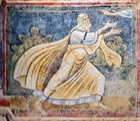
Scenes from the New Testament
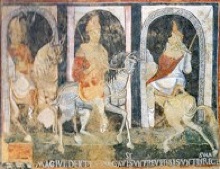
These frescoes on the right wall depict scenes from the life of Christ, from the Annunciation to the Way to Calvary. The scene illustrated here, which is under the 2nd and 3rd windows on the right, depicts the return of the Magi.
Cappella dei SS Lazzaro e Giovanni
The chapel to the left of the apse is dedicated to SS Lazarus and John, the monks whose hermitage was on the site chosen for the construction of the church.
Sarcophagi (3rd century AD)
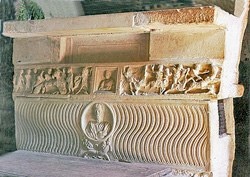
Two Roman sarcophagi (3rd century AD) under the altar have been re-used to house the presumed relics of SS Lazarus and John.
-
✴The upper sarcophagus. which now acts as a lid, is decorated with a relief of the original occupant and two hunting scenes.
-
✴The striated lower sarcophagus also has a relief of the original occupant. The grate to the right would have allowed the faithful to see the relics.
Dream of Duke Faroald II (16th century)

Madonna and Child with saints (1452)
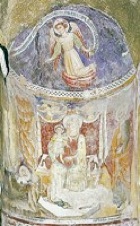
Apse
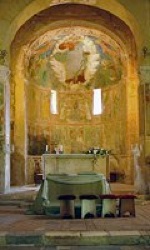
Altar frontal (ca. 740)
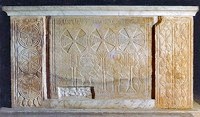
The carved marble frontal of the high altar contains reliefs of two men who are identified by the inscription along the top:
-
✴Ursus, the sculptor (who stands on the left and is also identified by the inscription in the discs he holds); and
-
✴Hilderic, Duke of Spoleto (739-4o), who commissioned the work.
The full inscription reads:
Hildericus Dagileopa in honorem
sancti Petri et amore sancti Leonis et sancti Grigori
pro remedio animae/ Ursus magester fecit
Some authorities suggest that Hilderic was known as "Hildericus Dagileopa", while others suggest that Dagileopa was his wife. It is interesting that Hilderic dedicated his altar to two former popes: Pope Leo I (440-61) and Pope Gregory I (590-604).
Ursus is also known from an inscription on a ciborium (712) from San Giorgio di Valpolicella, near Verona that King Liutprand commissioned. For the background on Duke Hilderic’s short reign as Duke of Spoleto as the appointee of King Liutprand, see the page on the Lombard Duchy of Spoleto.
There is another decorative marble panel at the rear of the altar.
Frescoes in the apse (15th century)
These frescoes which are attributed to the Maestro di Eggi, are in three registers:
-
✴Christ blessing, with six angels (above);
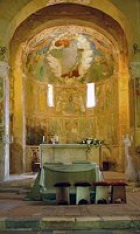
-
✴the Madonna and Child with angels and saints (between the windows); and
-
✴standing saints (below):
-
•SS Martial, Eleuterius and Lazarus on the left;
-
•St Benedict and his followers SS Maurus and Placidus in the centre; and
-
•three anchorite saints (of whom only the first, John, can be identified thanks to the inscription below) on the right.
The presence of SS Benedict, Maurus and Placidus is surprising because the frescoes were executed when the abbey no longer belonged to the Benedictines. This suggests that the present scenes reproduced the iconography of earlier ones. The arrangement of Umbrian hermits around these central figures suggests that the Benedictines saw themselves as the heirs of the local eremetical tradition.
Madonna and Child with saints (11th or 12th century)
This fresco of the Madonna and Child with four female saints is on the inner surface of the arch in front of the apse.
Sarcophagus of Duke Faroald II (3rd century AD)
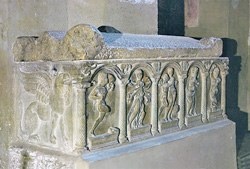
The sarcophagus to the right of the apse is believed to have bee re-used for Faroaldo II, who (as mentioned above) became a monk at the abbey after he was deposed and died here in ca. 728. The front has figures in five niches:
-
✴a satyr (half man, half goat);
-
✴a dancing maenad (participant in an orgiastic rite in honour of Dionysus);
-
✴Dionysus and a satyr;
-
✴an old man; and
-
✴the god Pan.
Right Transept
Madonna and Child with saints (1320)
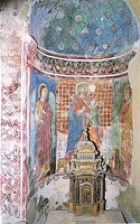
Sarcophagus (3rd century AD)
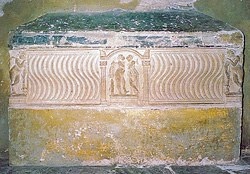
This sarcophagus on the back right wall contains a relief of Cupid and Psyche.
Ancaiani Monuments
These monuments on the back wall commemorate three members of this family who were commendary abbots here:
-
✴Aloisio Ancaiani (died 1503);
-
✴Benedetto Ancaiani (died 1617); and
-
✴Decio Ancaiani (died 1757).
Right Wall
Sarcophagus (3rd century AD)

This sarcophagus on the right of the nave contains a relief depicting a boar hunt (on the left) and hunters chasing an antelope (on the right).
SS Peter and Paul (11th century)
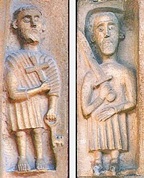
Counter-Facade
St Bernard (early 14th century)
This fresco is [where ?]. It was probably pained over an earlier fresco of St Bernard, the founder of the Cistercian Order, which would have been executed in the short period after 1234 in which the abbey was under Cistercian jurisdiction.
Art from the Church
Adoration of the Magi (1508)
Abbot Eusebio Ancaiani commissioned this documented altarpiece from Giovanni di Pietro, lo Spagna for the high altar. Abbot Decio Ancaiani moved it to the chapel next to Palazzo Ancaiani, Spoleto in 1733. The family took it to Rome in 1825 and sold it to the art gallery of Berlin in 1833. It is now in the Staatliche Museen, Berlin.
Read more:
C. Livoni, “L' Abbazia di S. Pietro in Valle in Valnerina”, (undated) Terni
Return to Monuments of Spoleto.
Return to the page on drives around Spoleto.

